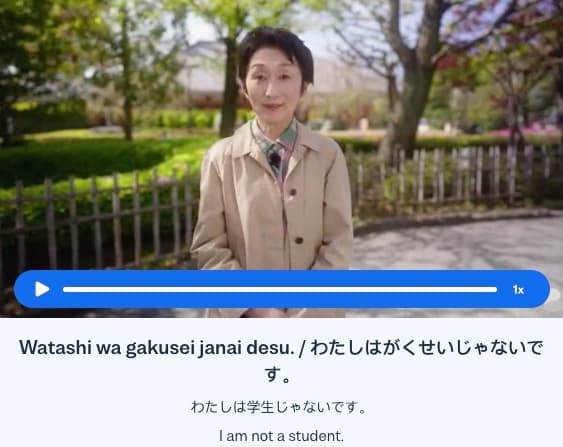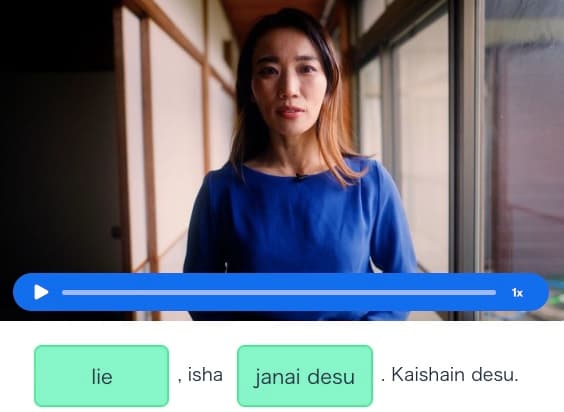I want to learn...
If you’re looking for the right way to politely (or not so politely) decline an offer or express your disagreement in Japanese, you’ve come to the right place. In this article, you’ll learn several different ways to say “no” in Japanese.
Note: Looking for information on the hiragana character no (の)? Check out our article on the Japanese writing systems or our guide to Japanese particles instead.
The short answer: No in Japanese
Let’s look at how to say, write, and spell “no” in Japanese.
How to say no in Japanese
Hiragana: いいえ
Romaji: iie
The textbook answer to how to say “no” in Japanese is to say iie– pronounced like “eee-eh” (a long “ee”, pronounced like the letter e, followed by a short “eh”, pronounced like the letter a).
If you learn Japanese, this is probably the first way you’ll learn to say no. And this is technically correct, and can even sometimes come in handy, depending on context. For example, if you’re filling out a form in Japanese, you’ll always see yes and no as hai and iie.
But the truth is, in most conversational situations, iie is the wrong word to use, even when you want to say no.
And why you shouldn’t say no in Japanese
Just like in English (but even more so!), sometimes a flat out rejection can come across as harsh in Japanese. In Japanese culture, it’s unusual to say a direct “no” to a request or offer, because it’s impolite. And iie, in particular, can come across as rude.
Iieis primarily used in answer to a question or to offer a correction, and paired with further explanation. And even then, fully saying iie can come off as cold and even rude. People might think they’ve upset you.
To soften this, instead of iie when a direct “no” is called for, Japanese speakers will usually say a casual iya (いや) or a shorter but still fairly formal ie (いえ).
For example, if someone asks if you’re a student, but you’re the teacher, you could use iie before correcting them. However, it might sound a little stiff and short, even in that situation, so a slightly less cold iya or ie could work. But if a friend asks you to meet for a drink after work or a client asks for a favor, these still aren’t the best options.
4 better ways to say no in Japanese
If you want to tell someone no in Japanese in a way that will feel more natural, here are three popular ways to answer in the negative.
1. Chotto (ちょっと)
Meaning: A little
This literally translates to “a little bit” and is a shortened version of the response “it’s a little bit difficult” or “I’m a little too busy”. You can fill in the excuse, or just leave it at chotto and people should understand that you’re politely declining. This is best for more casual use with friends and family.
2. Daijoubu desu (だいじょうぶ です) or kekkou desu (けっこうです)
Meaning: No, thank you
Daijoubu desu– meaning “it’s ok” or “I’m ok” – and kekkou desu– “it’s fine” – are both ways to say “no, thank you,” when offered something or invited somewhere. Kekkou desu is much more polite, while daijoubu and daijoubu desu are a little more casual.
Worth noting: While it’s used roughly like a “no, thank you,” it might be helpful to think of daijoubu desu as less like “no” and more like saying “I’m good” or “I’m fine.” So, if a server asks if you want another drink and you say daijoubu desu, you’re saying “no, I’m fine,” but if someone asks if the hot tub temperature is to your liking and you say daijoubu desu, you’re saying “yes, I’m fine.”
3. Sumimasen (すみません)
Meaning: Sorry, excuse me
Sumimasen can be handy in many different situations, including to say “sorry (but no)” in Japanese. It’s a humble way to express regret when speaking with strangers, acquaintances, or someone at work if you have to say no, but still want to express that you feel badly about saying no. If you want to know how to say no in Japanese politely, this is a good place to start.
4. Uun (ううん)
Meaning: Nuh-unh, hmm, mm-mm
Spelled like “uun” or “u–n,” this is usually pronounced more like just a long “nnn” and is often accompanied by shaking your head. (Think of the way we say “uh-huh” and “unh-unh” or “mhm” and “mm-mm” in English as a casual yes and no.)
Uun is best learned by watching and listening since it depends a little on intonation and body language, but once you get the hang of it, it can be very handy in casual conversation.
The long answer: There are also many other ways to say no in Japanese
So far, you’ve learned a few common ways to say no in informal situations, but there are many more! Let’s take a closer look at a few more popular ways to say “no,” “nuh-unh,” “no can do,” and “sorry, but I can’t.”
How to say no in Japanese (informal)
Here are three common, not-so-formal ways to tell someone, well, it’s not happening.
Muri (むり)
Meaning: Impossible
This is a strong no, typically used with a little sarcasm or humor among friends. It’s a simple, casual way to say “no way” to a friend’s invitation or suggestion.
Dame (ダメ)
Meaning: No good
Dame can mean “no good,” “not allowed,” “useless,” or “hopeless.” It can be used to say that a situation is hopeless, something is broken, to tell someone they shouldn’t do something – in fact, it’s a commonly used word with many possible uses. But one of them happens to be a firm no, in the right context. For example, if someone asked you if they could eat your sandwich, you could say dame to say no.
Dekinai (できない)
Meaning: Can not
To say you can’t do something, you can use the verb dekinai. It should be used in a full sentence or in response to a question or request that contains the verb dekiru (meaning can or to be able to). This is a polite but still fairly casual way to say “I can’t,” and can be used with friends or colleagues around the same status as you. The slightly more polite version, dekimasen, can also be useful.
No in Japanese (formal)
One of the reasons some people consider Japanese to be a particularly difficult language to learn is because there are different Japanese honorifics and levels of speech, and mastering keigo, or Japanese for business, can be uniquely tricky.
So, how do you say no in Japanese at work?
Here are three common, work-appropriate, more formal ways to tell someone “no” in Japanese:
Kibishii desu (きびしいです)
Meaning: Hard (conditions), strict
Kibishii desu is a way to express that you’re unsure about a request, whether you’re not sure if it’s possible or just unsure whether you’re willing to do it. Regardless, it expresses uncertainty but isn’t necessarily a hard no – though it certainly suggests things are trending toward “no.”
Muzukashii desu (むずかしいです)
Meaning: Difficult
Muzukashii desu, on the other hand, is understood as a fairly clear (but polite) no. While the direct translation – “mentally difficult” or “hard” – is about as ambiguous as kibishii desu, muzukashii desu is really used to say, “it’s not going to happen.” You might even hear it in the case of reassuring someone that something won’t happen. It means doing whatever is being asked of you would be difficult for you and you’d rather not go through with it.
Taihen desu (たいへんです)
Meaning: Hard (task)
Taihen desu is similar to muzukashii desu – it’s a fairly clear way to tell someone that something probably won’t happen – but it implies that the request is too physically hard or laborious (whereas muzukashii desu is more mental or emotional). If you’re too tired to go out or would hurt your back lifting one more box, it’s taihen desu.
When maybe means no in Japanese
Have you ever been asked to do something you didn’t want to and responded with “maybe,” knowing full well you weren’t planning to call for a second date or read that book? Well, these phrases are like that, but in Japanese. What you’re literally saying is a kind of “maybe”, but by not saying yes, in some contexts, it’s understood that it’s probably a no.
Rinkiouhen ni taiou suru (りんきおうへん に たいおう する)
Meaning: Depends, let’s play it by ear
If you hear this sentence, while it’s a little ambiguous, you should prepare yourself for the possibility that someone is saying “no” to you. On the flip side, if you’re looking to politely push off saying no to someone, rinkiouhen ne taiou suru can be a gentle way to do it.
…kamo shiremasen (…かも しれません) or …kamo shirenai (…かも しれない)
Meaning: Perhaps, maybe not, might not happen
This phrase is similar to rinkiouhen ne taiou suru but, instead of standing alone, it’s added to a sentence to express that something might not happen.
For example, you could say:
午後6時の電車に間に合わないかもしれない。
Gogo 6-ji no densha ni maniawanai kamo shirenai.
I might miss the 6pm train.
彼はカラオケに来ないかもしれません。
Kare wa karaoke ni konai kamo shiremasen.
He may not come to karaoke.
Of course, as with saying “maybe” to anything, there’s some gray area here. Sometimes people really do want to play something by ear. Or sometimes, a maybe is just a maybe. And sometimes they’re just being polite and not saying no directly. Context clues are everything!
Yes and no: Watch out for soundalikes
There are a few Japanese responses that can sound very similar, but one means yes and the other means no.
We talked a little bit about uun earlier, but the “yes” version of this sound is simply un (うん)– a shorter, more affirmative sound, usually accompanied by nodding or other clarifying body language.
Similarly, while a direct translation of “no” is iie, ie, or iya, you can say yes with ee (ええ), meaning good, which can sound like iie or ie if you’re not listening closely.
As you can probably guess, with all these subtleties, the best thing to do is practice listening and speaking with help from Japanese native speakers to make sure you understand and are understood – and that you’re saying no in the right way for the situation.
AUTHOR

Emily Duncan
Newlanguages


